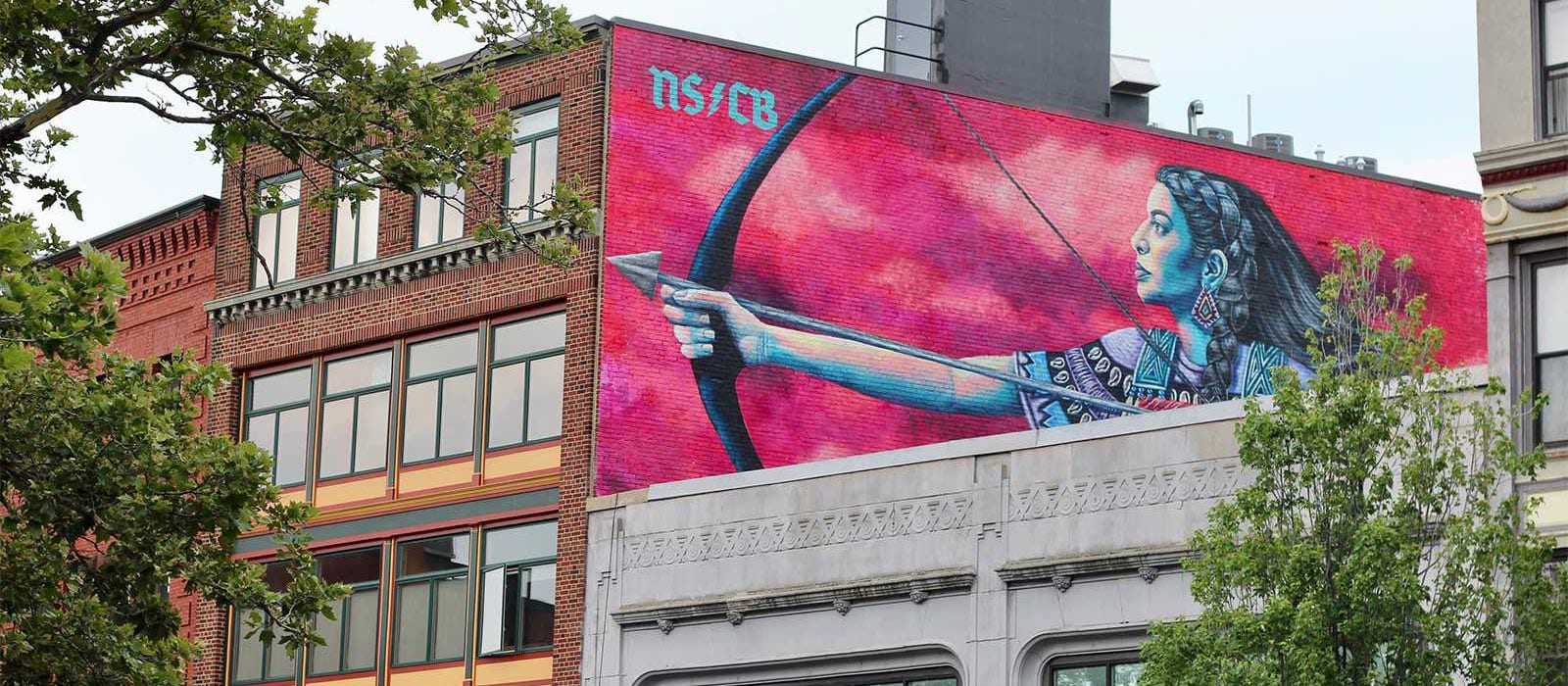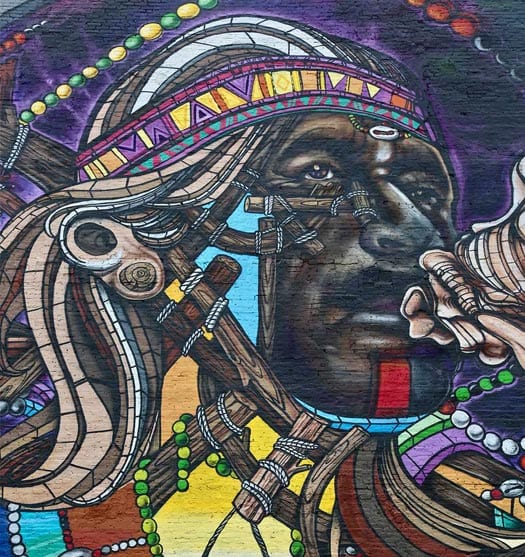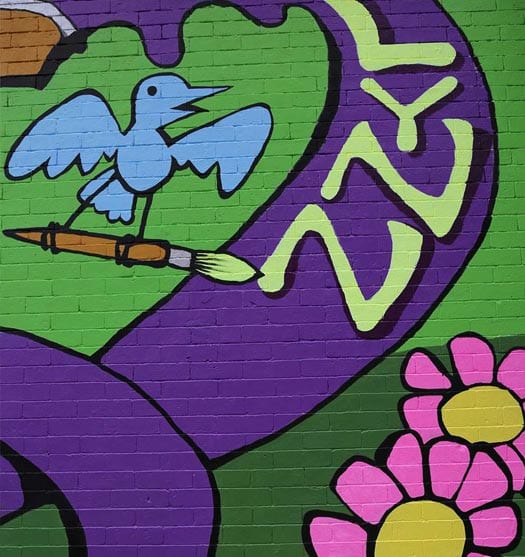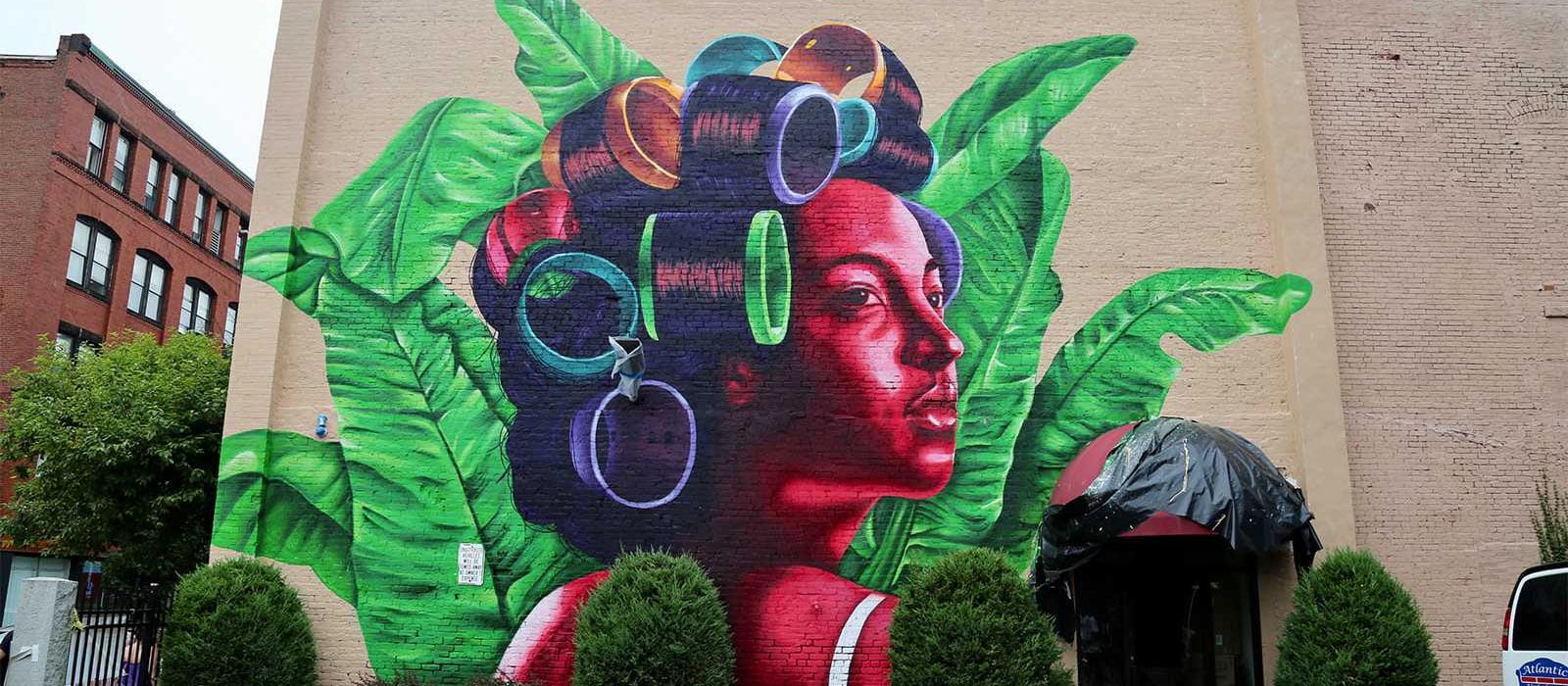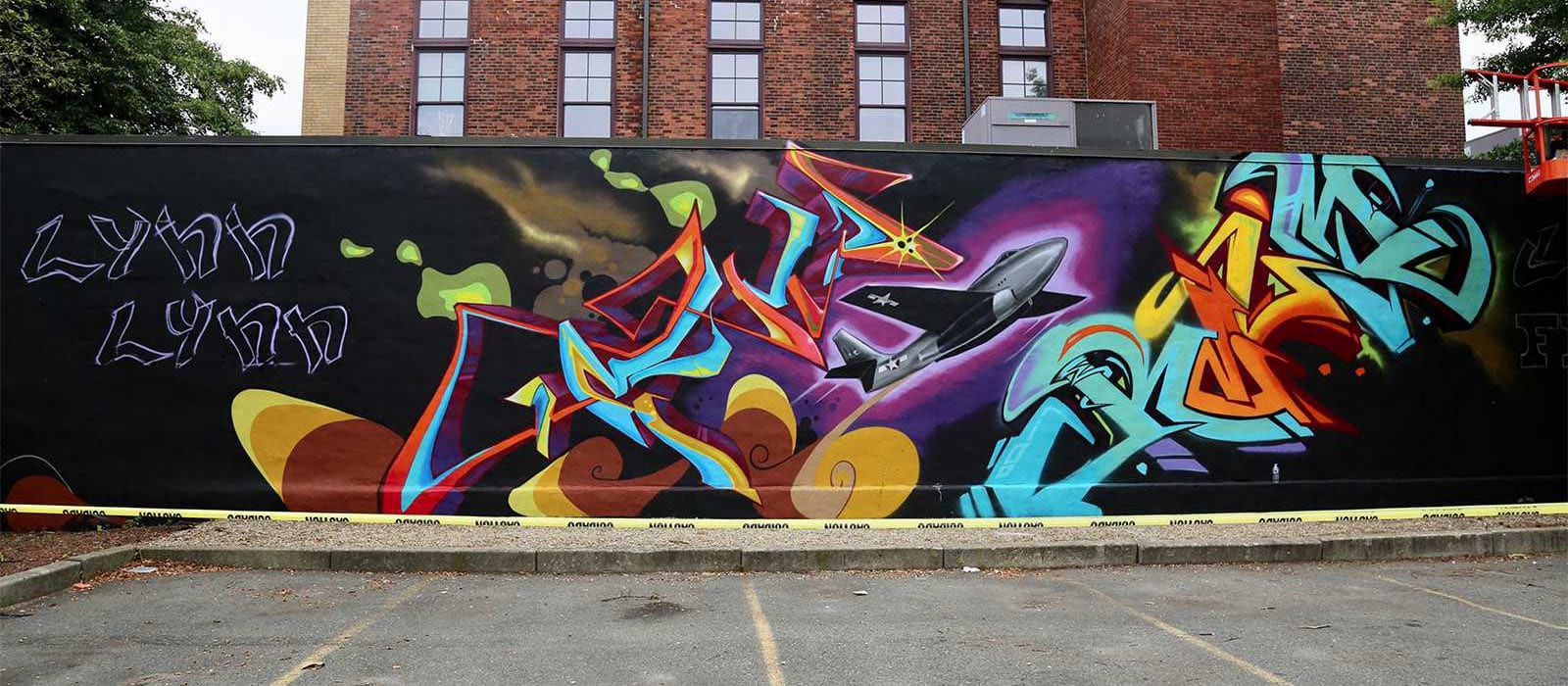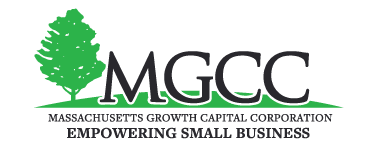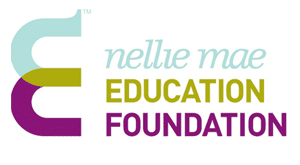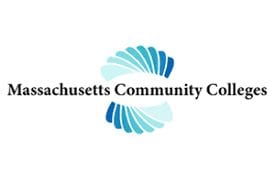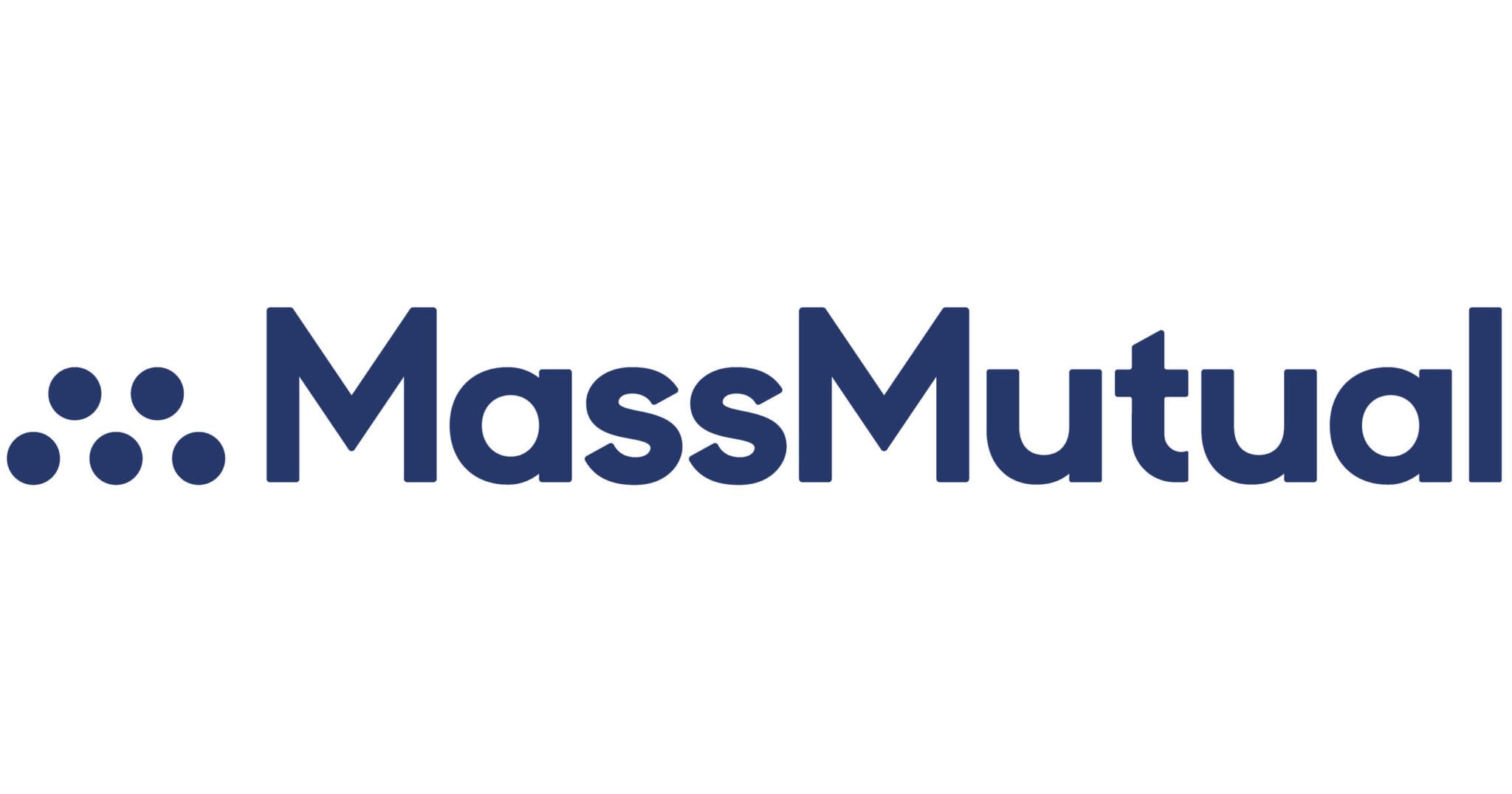As we’re led on a tour of downtown Lynn, a local driver slows, sticking his head out his truck window to call out to our group.
“Hey Al, they look great!”
Al Wilson, bearded and a bit disheveled, grins and stretches out a hand in gratitude. “Thanks, brother!”
The driver is referencing the looming murals in front of us, in various stages of completion. They are the flagship project of Beyond Walls, Wilson’s creative placemaking initiative in Lynn, Massachusetts. The truck driver is one of many to stop him on the street offering excitement and congratulations.
“This makes me so proud to be from here!” exclaims Diana Vasquez, a mentoring coordinator at La Vida Scholars Americorps in Lynn. Flanked by two friends, she gazes wide-eyed at a white washed wall, where Angurria is perched atop a car-sized hydraulic lift. Angurria, an artist from the Dominican Republic, is spray-painting huge swaths of color that will eventually form a woman’s face.
Angurria’s mural is one of 15 clustured downtown, designed to be seen from both street level and the city’s raised MBTA rail. The content ranges from people and words to traditional styles of graffiti, and they flow from one to the next, as if in procession through the streets.
Beyond Walls is tackling placemaking on a massive scale. In addition to the murals, there are in-progress initiatives to light the MBTA underpass with colored LEDs, place a collection of vintage neon signs along the sidewalks and put a GE jet engine sculpture installation in a to be determined location.
Public art is notoriously difficult. Even when attempted, it is not always successful. But Beyond Walls’ key move was to involve the community from the start and make Lynn’s citizens central to the development, planning and execution.
“Beyond Walls did well by having community conversations and business conversations,” says E. San San Wong, Director of Arts and Creativity at the Barr Foundation. “It engenders a sense of ownership — people feel a relationship to the project] already.”
In Lynn, creative placemaking — the intentional use of the arts in placebased community development — is being used to address economic, safety and perception issues. Lynn is a former industrial city. In the 1800s Lynn was considered the shoe capital of the world with over 200 shoe factories, and General Electric, which still employs Lynn residents, has been in the city since before World War I — the first American made jet-engine was made here, and so were some of the fuel cells for the Gemini spacecraft.
But like many former industrial giants, Lynn was hit with economic decline, increased homelessness and an increased presence of social services. The current poverty rate in Lynn is 21 percent. The resulting negative perception has been persistent. However the city’s urban structure and commercial downtown made it a prime candidate for ass Development’s Transformative Development Initiative (TDI).
The TDI program uses targeted investments and partnerships spearheaded by fellows on the ground to revitalize Gateway City communities. Joe Mulligan III, one of the inaugural TDI fellows, has been in Lynn since 2016.
Transformative Development
MassDevelopment is the Commonwealth’s economic development and finance authority, a quasi-public organization working to stimulate business and drive economic growth. MassDevelopment implemented the Transformative Development Initiative (TDI) pursuant to C. 289 Acts of 2014, legislation promoting economic growth across the Commonwealth. MassINC’s relentless research and commitment to transformative development strategy, put forth in a 2013 white paper, was instrumental to the legislation’s adoption. The TDI program uses targeted investments in compact, strategically located areas within the Gateway Cities to increase local public/private engagement, spur economic activity, and promote and improve an overall quality of life. Twenty-six Gateway Cities were eligible for the 3-year pilot program; 10 were selected, including Lynn.
“80 percent of my time is spent in Lynn,” says Mulligan, who likens the match up of fellows and their respective cities to speed dating. He came to the program with a background in architecture, and matched with Lynn in part because of its substantial urban structure. “I’m always trying to meet [people], understand [the community] and get a sense of living in the downtown area.”
MassDevelopment had already conducted community meetings and designed action strategies for Lynn, which were then used as the groundwork for Wilson’s project. Capitalizing on that foundation and collaborating with Mulligan, Wilson hosted more meetings to determine Beyond Walls’ trajectory. Though he already had public art in mind, he wanted to ensure whatever they created actually met the community’s needs.
“It feels really great that Al spread a net to include the whole community,” says Carly McLain, executive council for the Lynn Housing Authority and member of the Beyond Walls committee. “I love it here, and it’s nice to see other people join in that enthusiasm.”
The feedback prioritized a handful of issues — safety near the MBTA underpass, development of local business and engagement of the sidewalk space to increase downtown’s walkability.
“It was clearly the mission of Beyond Walls to improve the lives of the people who live and work here now, and attract a change to the narrative of Lynn,” says Wilson.
Those issues directed the four prongs of Beyond Walls: LED lighting in the underpass, neon signs on the sidewalk, a historic sculpture installation and the banner project, 15 public murals painted by international and local artists.
Funding is a major obstacle to public art of any kind. In Lynn, the housing authority’s nonprofit arm served as Wilson’s fiscal agent. This gave him access to a multitude of grant applications, including the Commonwealth Places Program. The rollout of this partnership connected Wilson to the first member of his team, Amanda Hill.
“I WAS looking for someone [to] help with the operational side of things,” says Wilson. They had connected once before through RAW Artworks, a Lynn-based nonprofit using art therapy to reach at-risk youth. Hill joined the project as a volunteer associate director, eventually leaving her role at RAW Artworks to dedicate herself to Beyond Walls full time.
Next to join was Pedro Soto.
“Pedro is a fantastic young guy who immediately bought into the project,” says Wilson.
Soto is a Lynn resident with a background in urban planning and project management. “I felt really excited about offering my skills and experience to a project right in my backyard,” says Soto.
Soto, of Dominican Republic descent, is also a Spanish speaker, making him essential to successfully communicating the Beyond Walls mission to the one-third of downtown Lynn that is Hispanic.
In addition to Lynn’s residents, Beyond Walls received support from local and state government figures. Through the MassDevelopment partnership, state senator Tom McGee and state representatives Daniel Cahill and Brendan Crighton sent letters detailing their support.
“The arts have become an important part of the economy in the downtown, says Representative Daniel Cahill in a statement. “The support of the community has been tremendous and I truly believe that this is a great step forward as we continue to revitalize the downtown area.”
The final Beyond Walls volunteer committee totaled 24 people: Hill, Soto and 21 residents and business owners, with Wilson as Executive Director. It specifically included members that represented the breadth of diversity in downtown Lynn.
Commonwealth Places
The Commonwealth Places Program is a MassDevelopment and Patronicity partnership helping local residents crowdfund support for place-based community projects. MassDevelopment backs successful proposals with a 1:1 matching grant of all crowdsourced funds up to $50,000. To receive the grant, projects must reach their proposed target within 60 days. The majority of funding for Beyond Walls came from smaller donations to the Patronicity campaign. They surpassed their goal of the maximum $50,000 within 16 days. “Al took it beyond expectations,” says Joe Mulligan, the TDI Fellow in Lynn. “The Commonwealth Places Program gave him the launch he needed.”
“I wanted [the community] to see we had a representative from the various cultural groups and institutions here.”
Cultural representation was also translated through the art, as Wilson emphasized a selection of not only diverse artists, but also artists whose subject matter features people of color.
“Many of the murals are representations of the various ethnic groups that call downtown Lynn home,” says Soto. “I felt that this project would serve as a source of empowerment for little boys and girls that identify as minorities.”
That emphasis on representation drew Soto to the project.
“This is a community of color,” says Wilson. “This downtown is a majority minority area, and it should feature art that is reflective of that community.”
LAUNCHING Beyond Walls required the collective efforts of the team, but the driving force is Al Wilson. Wilson exudes captivating charisma. He engages strangers with the friendliness of an old and close friend, often interrupting his own narrative to draw attention to a particularly striking mural.
It’s a quality that has served him well, allowing him to float comfortably between the community, the artists at work and among business leaders in the boardroom in relentless pursuit of funding. Wilson appeared in person for every appeal for donations or grants over $1000, meeting with local banks and credit unions as well as individual businesses.
“In Lynn, the business leaders are optimistic,” he says. He would meet one-on-one with the decision makers of the companies, discussing their business, their connection to Lynn and finally asking for their support at a specific monetary level.
Every meeting, even those that didn’t result in funding, built a valuable relationship. Wilson stresses that the key strategy was to end the week with more meetings on the schedule than when he started. “You always have to be selling and keep a robust pipeline,” he says. “Don’t be discouraged by the no.”
In all, Wilson held approximately 50 of these meetings.
He persuaded other organizations to contribute not only funding, but also in-kind labor. The International Union of Painters and Allied Trades DC 35 and International Brotherhood of Electrical Workers (IBEW) Local 103 both provided physical support: the painters supplied the primer and prepared the walls for the artists, and the electrical workers plan to lend their expertise to the installation of the neon and underpass lighting.
Special events also contributed to the fundraising effort. Beyond Walls hosted a meet-the-team event at the Lynn Museum, attracting over 200 people, and the Blue Ox, a local restaurant, hosted an evening with a specialty cocktail, the proceeds of the drink going to Beyond Walls.
Boardrooms and business meetings are nothing new for Wilson, who came to Lynn from the private sector. Working for a Chicago-based start up, he opened the company’s Boston office in 2014 and moved to the North Shore. His morning commute took him through Lynn and re-oriented him to the city — he grew up in Walpole, Massachusetts and spent his childhood on the soccer pitch playing against teams from Lynn.
After two years, the company needed him to close a number of offices and relocate to Chicago. Instead, Wilson walked away.
“I didn’t want to go through laying people off, I’d done that several times over. To be honest, I was burnt out,” he says. “I was left feeling empty. I made money, and that was a good run, but what did we really do at the end of it? What change or impact did we have on people’s lives?”
Staying on the North Shore, Wilson shifted his focus, prioritizing the pursuit of community impact.
Wilson’s inspiration for Beyond Walls came from a trip to Wynwood Walls, a Miami industrial zone warehouse district turned street art destination. It began in 2009, spearheaded by the late Tony Goldman with six warehouse walls, and has since expanded to include over 80,000 feet of walls, unfurling into the surrounding neighborhood.
“I thought, what a cool story,” says Wilson. “It’s a really vibrant community, with tons of commerce on the street level — this guy takes asphalt with some broken down warehouses and he says in five years I’ll have this cultural Mecca, despite the fact that we’re inland, away from the hotspots. You’d think this guy was crazy, but it happened.”
SELECTING the artists for the Beyond Walls murals was an arduous process — street art is a world-renowned art form with distinctive styles and genres, and the committee approved the best. They also required that those artists be representative of the cultural diversity in Lynn, looking specifically for artists who were themselves part of those cultural groups.
After releasing an open call for proposals, Wilson and the committee accepted 50 applications from both domestic and international artists and made a number of direct requests for work. They finalized a list of 15 artists whom they considered to be at the top of their field. One artist is Cey Adams, a distinguished Brooklyn-based graffiti artist and industry giant, famous for his work as the founding creative director of Def Jam Recordings.
“He did the cover for LL Cool J, he was there when they discovered the Beastie Boys, Mary J Blige,” says Wilson. Adams also created album covers and advertising campaigns for Run DMC, Public Enemy, Notorious B.I.G. and Maroon 5.
“He’s got the best stories,” adds Wilson.
Adams also exhibits and lectures in major New York art institutions, including MoMa, the Brooklyn Museum and New York University. Despite his celebrity status, in Lynn he was as much a part of the team as anyone. He responded to the open application and stayed in the Salem State University dorms alongside the other artists while painting.
Inspiration
While working through ideas for Beyond Walls, Wilson also looked at placemaking locally and overseas. Worcester has implemented a number of cultural development and public art programs. The Public Art Working Group, a subset of the Worcester Cultural Coalition, commissions large-scale public art, including a 2014 mural by Beyond Walls artist Caleb Neelon. The working group also supported the 2016 Make Art Everywhere campaign, which provides opportunities for local artists to contribute to permanent and temporary public art installations, helping to identify Worcester as a creative city. In London, Futurecity founder Mark Davy works to implement arts and culture strategies into primarily property- based development. Futurecity creates placemaking strategies for singular projects, navigates partnerships with local cultural institutions, and works with international artists and designers to commission major public art and architecture installations, both temporary and permanent. Their portfolio includes Richard Wilson’s Slipstream, an internationally acclaimed sculpture installation in Heathrow Terminal 2, Mark Wallinger’s White Horse, a 50-meter installation in Ebbsfleet Garden City and Glass Mill, a multi-colored building façade in Lewisham, London.
Some artists were brought in on direct appeals, like Temp, who was a high priority get due to his local ties. Temp grew up in Lynn, and was a prolific street artist in the 1980s, putting work on many of the surfaces now being used in Beyond Walls. Known for distinctive abstract lettering — his talent also extends into traditional forms of sketching and painting — Temp’s work became so well known in the street art community that Lynn claimed its own identifiable style. Beyond Walls artist Caleb Neelon, based in Cambridge, subsequently documented “Lynn-style,” in the “History of American Graffiti.”
“This is my home, so [Beyond Walls] is super special for me,” says Temp. “They did it right. It puts some smiles on people’s faces, brightening the city. Downtown came to life.”
Temp’s mural is a partnership with Relm, another local Lynn artist who Temp mentored in the 1990s. The painting has elements to appeal to both younger and older generations of their hometown. The foundation is built from graffiti style lettering, and it features a jet plane in homage to Lynn’s industrial roots — the city plated a major role in aviation development, and GE
built the first American-made jet engine in Lynn.
DESPITE the expressed interest, there were significant challenges that could have stalled or even stopped the project.For one, the subjective nature of art can make public installation difficult.
“The challenge with art is what emotional response it evokes is based on the individual,” says Wilson. “And when you have condo associations, or building owners who have been here for some time [and] get stuck in the what-if scenarios, it’s a challenge.” The building being used for Temp’s mural, for example, nearly wasn’t an option. The building owners were hesitant, so Wilson brought them to the Beyond Walls office to show them the plan for their wall.
The husband didn’t like the sketch. His wife did.
“Inside I’m double fist-pumping because I know that’s the decision maker right there!” says Wilson, laughing.
“And ultimately, the husband is coming to the site three times a day. He’s taking photos and is so excited,” he continues. “Doing public work, you’re going to have doubters and critics. I think what’s been really interesting is to see as the art’s gone up, those parties have really started to embrace it in a big way.”
The logistical challenges were also significant, and made up a large part of the committee’s efforts.
While searching for artists, the team had to ensure they had the proper canvases — the walls themselves. They identified 62 walls, then Wilson began working various channels to pin down the final 15 plus back-up agreements.
These couldn’t be just any walls. The spaces needed to be visible from multiple vantage points and work in conjunction with one another. They also needed to be appropriate for each artist’s style. Marka27, for example, a Mexican artist, only does extremely
large-scale work — his canvas needed to be one of the tallest buildings in Lynn.
The committee itself formed smaller groups based on skill sets. The legal committee, or No Fun Committee as they became known, handled all legal components. This included wall agreements with building owners, insurance, licensing of the murals to the artists and a promise to keep the murals up and intact for one year.
“The building owners, who own the walls, they’re the unsung heroes,” says Wilson. “They had to believe in it, agree to it and put up a piece knowing that if [it] wasn’t collectively viewed as positive, they’d get the wrath.” Even with building agreements in
place, space caused more complications. Each artist uses a car-sized, motorized hydraulic lift with an extendable arm that often takes up space in parking lots. In the case of Temp’s wall, on top of access agreements and insurance, they needed residential approval to take over parking spaces and to let the adjacent building, which shares the lot, know of what they were doing.
“There are a lot of boxes to check,” says Wilson.
Personal challenges abound as well, stemming from how much of himself Wilson has thrown into the project. He has committed to this as a full-time occupation and he does not make any money doing so. More than anything though, he fought against self-doubt.
“On any given day, I have literally every emotion you can have as a human,” says Wilson. “The hardest part is the stuff that comes into your head when you’re falling asleep at night. You’re doing something people don’t quite understand, and yet publically, you have to have a persona of no doubt.” Al took a moment to reflect. “I had a career, and I had a lot of parties that were looking to what I was doing next,” he says. “They have a trajectory, and you’re stepping away from that. I had business mentors that I think…I don’t know if they could get it.”
But then there are the moments that assure him of his choice. Wilson tells the story of finding a couple in front of FONKi’s mural, a beautiful rendering of a Latina woman against a brick wall. The couple had been high school sweethearts in Lynn — now married, they lived in New Hampshire, but had come back to Lynn to see the mural festival. When Wilson came across them, they were crying.
“They just never thought something like that was going to happen in Lynn,” he says. This is a common refrain, and one of the critiques of some public art: it is so often put in places that don’t necessarily need it.
“Why do we have to only put public art in places that are already proud,” asks Kate Chertavian of Kate Chertavian Fine Art. “The idea that just because you live in a community that’s outside the mainstream means you don’t have an eye for beauty? I find that rather offensive.
“Put great, meaningful and relevant art in communities that are underserved and it changes the conversation. It reverses the conversation of cities.” “[Beyond Walls] is wonderful in the walls they chose — some of them appear to be in conversation in one another,” Wong, from the Barr Foundation, says. “The execution and mastery of work, and the stories they’re telling of community — it makes you rethink where it is you’re standing.”
CREATIVE placemaking has both quantifiable economic benefits, and the less easily quantified but equally important impact of vitality and human presence. In Lynn, even before the murals were complete, both forms were evident.
Local businesses increased traffic during the week of painting, and some have sustained that growth. The White Rose Coffee Shop, which added an extra business day during painting, has since reported an increase of three times their prior rate of weekend commerce. They’ve hired two additional staff members to handle the uptick in business.
In late 2017, Beyond Walls will release a full report on the economic impact of the project. “I think the tide has risen for all parties,”
says Wilson. Michael Mageary, Lynn’s Chief of Police, has also noticed changes in the look and feel of the city’s downtown. “I can definitely see improvement, “ he says. “I was walking in uniform, and I noticed the cleanliness around — there’s positive impact here.” “Beyond Walls has done an amazing job of highlighting Lynn’s proud and diverse community,” says State Representative Brendan Crighton in a statement. “These murals in Lynn’s growing public art scene beautify our neighborhoods, inspire our youth and attract thousands of visitors.”
Wilson, the team and the artists involved are happy to see the positive impact ripple through the community. “This project has been a great source of pride for folks who call Lynn home,” says Soto. “It’s bigger than the artists and this moment,” explains artist Marka27, whose mural features a young child of color. “You’re thinking about the 10-year-old who will grow up with this. It’s long-term.” Angurria has already noticed this with his mural. “The child saw it, came back with mom and dad,” says Angurria in a mix
of English and Spanish. “They said, ‘Look here mom, it’s grandma!’” “Everyone says thank you,” he adds. “I’m happy. I’m proud.”
“It’s the little moments,” says Wilson. “Finding that couple in front of the piece, getting people to celebrate, finding the people who were really against it are suddenly [on board] — I think the highest praise you can get is when all parties are collectively taking
responsibility for it.”
With the murals done, Beyond Walls is not finished. They’ve now moved into the final design and approval stages for the underpass lights and are preparing to install the neon signage. The team is also looking to file paperwork in 2018 to become a fiscally independent entity.
When everything is complete, Wilson is looking forward to tackling even more creative placemaking. He plans to do so while staying local and bringing his work into other equally deserving communities.
“I’d like to stay in the space,” says Wilson. “I’d like to stay in Lynn, continue doing work [here], but I’ve got some visions for the other Gateway Cities. Ultimately what we’re doing [is], we’re putting art on walls, and we’re putting lights up in areas that are currently dark. We’ve got this.”
WHERE TO FIND THE MURALS IN LYNN
Angurria Dominican Republic
516 Washington Street
Bruce Orr and Good To Go (RAW) Lynn
129 Munroe St/515 Washington Street
Caleb Neelon Boston
33 Munroe Street
Cedric ‘Vise’ Douglas and Julez Roth Boston
114-120 Munroe Street
Cey Adams New York City
65 Munroe Street
David Zayas Puerto Rico
65 Munroe Street
Don Rimx Miami
129 Munroe Street/515 Washington Street back side
FONKi Montreal
18 Munroe Street
Georgia Hill Australia
85 Munroe Street
Marka27 New York
31 Exchange Street
Miss Zukie & JPO New York City and Connecticut
16 City Hall Square
NS/CB (Nicole Salgar and Chuck Berrett)
Florida/New York
33 Central Street
Tallboy (Chris Coulon) and Brian Denahy Lynn/North Shore
31 Spring Street
Team Rekloos: Brian Life, Brand Rockwell, and Raodee Boston
69 Exchange Street
Temp & Relm Lynn/North Carolina
173 Oxford Street



